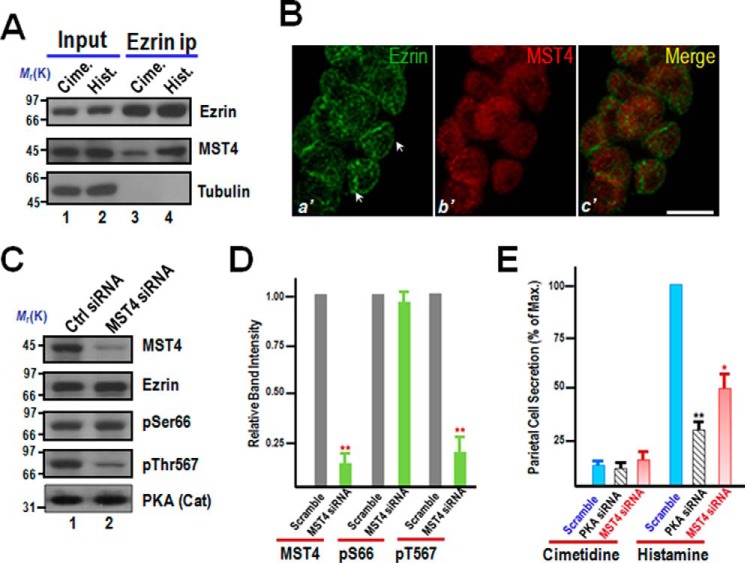FIGURE 2.
MST4 is essential for gastric parietal cell acid secretion elicited by histamine. A, phosphorylation of Ser-66 of ezrin promotes its association with MST4. Parietal cell lysates from cimetidine (Cime)- and histamine (Hist)-stimulated samples were clarified and incubated with ezrin affinity matrix. Beads were washed and boiled in SDS-PAGE sample buffer, followed by Western blot analyses of proteins bound to the beads. Note that a higher level of MST4 was immunoprecipitated by ezrin antibody from the secreting parietal cell fraction. B, MST4 specifically localizes to gastric parietal cells. Double immunofluorescence microscopic analyses show the co-existence of ezrin and MST4 in parietal cells using isolated gastric glands from rabbit. Scale bar = 10 μm. C, MST4 is responsible for Thr-567 phosphorylation during acid secretion by histamine stimulation. Aliquots of cultured parietal cells were transfected to introduce MST4 siRNA and control oligonucleotide. 24 h after transfection, parietal cells were stimulated with 100 μm histamine plus 50 μm IBMX for 20 min, and then cell lysates were generated and clarified for Western blot analyses of MST4 knockdown efficiency and its impact on ezrin phosphorylation. Note that MST4 was suppressed by siRNA treatment, which did not change the level of Ser(P)-66 but suppressed the level of Thr(P)-567. Ctrl, control. D, quantification of the level of MST4, Ser(P)-66-ezrin, and Thr(P)-567-ezrin in parietal cells treated with MST4 siRNA. The control experiment was done using a scrambled oligonucleotide or irrelevant siRNA. Error bars represent the mean ± S.E. of three separate preparations. **, p < 0.01 compared with the scramble siRNA-transfected control. E, MST4 is essential for parietal cell acid secretion. Aliquots of cultured parietal cells were transfected with MST4 and PKA (catalytic subunit) siRNA and scrambled oligonucleotides, followed by a standardized AP uptake assay. **, p < 0.01; *, p < 0.05 compared with stimulated controls. Max., maximal stimulation. Error bars represent the mean ± S.E. of three separate preparations.

